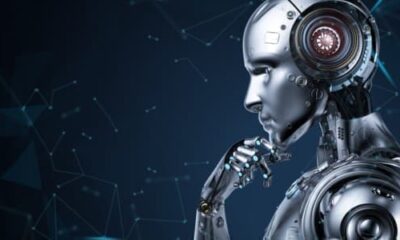Science
Tech Innovator Amandipp Singh Transforms Hiring for Disabled

Amandipp Singh, the visionary behind **Enabled Talent**, has launched a groundbreaking digital employment platform aimed at improving hiring practices for individuals with disabilities. This initiative seeks to dismantle barriers that have historically hindered access to employment opportunities, particularly for those with vision impairments.
Singh’s own challenges began early in life when he underwent multiple eye surgeries due to a condition that left him with limited vision. These experiences shaped his understanding of the significant employment gap faced by individuals with disabilities, prompting him to create a solution that not only addresses these issues but also aims to change the perception of disability inclusion in the workplace.
Enabled Talent, based in Ontario, is designed to match job seekers with disabilities to employers in a more effective manner. The platform utilizes artificial intelligence to adapt to the unique access needs of users, providing tailored hiring and onboarding solutions. Singh envisions this inclusive approach as a fundamental component of workforce development rather than a supplementary feature.
Partnership with Algoma University
In a significant step forward, Enabled Talent recently announced a research partnership with **Algoma University**. This collaboration focuses on the development of **Eynable**, an AI-powered accessibility tool designed to assist visually impaired individuals in their daily work tasks. The initiative reflects Singh’s commitment to employing technology to foster inclusivity in the workplace.
This partnership is just one part of Singh’s broader plan to extend Enabled Talent’s reach. The company is set to expand its operations nationally with a new base in **Alberta** later this year, while also venturing internationally through **Enabled Africa**. The initial rollout will target **Ghana** and **Nigeria**, supported by the **UNICEF Startup Lab**. Singh hopes to eventually make much of the toolset open-source, allowing other organizations to build upon it.
Addressing the Employment Gap
The employment landscape for individuals with disabilities remains stark. As of 2024, the employment rate for working-age adults with disabilities in Canada stands at **46.4%**, compared to **66.2%** for those without disabilities. Over **850,000** individuals with disabilities in Canada are ready to work but remain excluded from the labor market. Globally, more than one billion people live with disabilities, with over **70%** facing barriers to formal employment.
Singh highlights a common misconception that disability inclusion should be the responsibility of nonprofits or government entities. He argues that the real challenge lies in reassessing how talent systems are structured to ensure they are inclusive. Singh states, “Everyone is doing the same thing, creating some similar platform. But let’s say you are speaking French. I’m speaking Spanish. No matter how much we try, we won’t be able to communicate.”
Enabled Talent aims to treat inclusive hiring as a challenge requiring systems-level innovation. With over a decade of experience working with grassroots organizations, Singh’s approach emphasizes co-designing solutions with user groups that represent various disabilities. This collaboration has informed the platform’s accessibility pathways, ensuring they meet the needs of diverse users.
The platform is free for job seekers and is supported by employers who benefit from hiring tools tailored to their organizational needs. Features include voice-guided navigation for individuals with visual impairments, chat-based guidance for neurodivergent users, and sign language interfaces for Deaf individuals. For employers, the system simplifies hiring by recommending pre-matched candidates based on job requirements and accessibility needs.
“We’re not building a patch,” Singh asserts. “We’re building infrastructure.”
Reframing Inclusion as Innovation
The innovative design process at Enabled Talent has broader implications, extending beyond human resources. It serves as a model for crafting services in an increasingly complex and diverse environment. The approach, co-created with various disability communities, exemplifies the principle that those closest to a problem should be involved in developing the solution.
Public sector leaders, employers, and educators are learning that inclusive systems require more than generic policies; they must be built on a foundation that recognizes and adapts to differences from the outset. Canada’s initiatives, such as the **“Nothing Without Us”** strategy and the goal for a barrier-free Canada by **2040**, reflect a growing recognition that disability inclusion is a critical national productivity issue.
Creating Opportunities in the Labor Market
In a labor market where companies struggle to fill roles, overlooking a significant portion of the population poses both ethical and economic challenges. Singh emphasizes, “Talent is already here, but by not having accessible pathways, companies are missing out.” He notes that many qualified individuals, akin to renowned figures like **Stephen Hawking** and **Helen Keller**, are overlooked due to inadequate systems.
The consequences of excluding individuals with disabilities extend beyond individual opportunities; it can cost economies up to **7%** of their GDP. In contrast, companies that prioritize inclusion report **28%** higher revenue, double the net income, and **30%** greater profit margins. Singh identifies not only structural barriers but also psychological ones, as many individuals with non-visible disabilities fear that disclosing their status may jeopardize their job prospects.
By reframing inclusion as an innovative necessity rather than an obligation, Enabled Talent aims to effect meaningful change. Singh reflects on his childhood struggles for access to education, stating, “Even if it is **0.01%** improvement or change every day, that will one day turn into a ripple effect.”
The message is clear: building for difference from the outset accelerates growth and inclusivity. Designing with an understanding of how people actually work and live is crucial for creating effective systems. Tools developed for those on the margins often raise standards for everyone, shaping the future of various fields, including education technology, human resources, and user experience design.
As the conversation on inclusion evolves, Singh’s work stands as a testament to the potential for innovation when barriers are dismantled and opportunities are made accessible to all.
-

 Education3 months ago
Education3 months agoBrandon University’s Failed $5 Million Project Sparks Oversight Review
-

 Science4 months ago
Science4 months agoMicrosoft Confirms U.S. Law Overrules Canadian Data Sovereignty
-

 Lifestyle4 months ago
Lifestyle4 months agoWinnipeg Celebrates Culinary Creativity During Le Burger Week 2025
-

 Health4 months ago
Health4 months agoMontreal’s Groupe Marcelle Leads Canadian Cosmetic Industry Growth
-

 Technology4 months ago
Technology4 months agoDragon Ball: Sparking! Zero Launching on Switch and Switch 2 This November
-

 Education4 months ago
Education4 months agoRed River College Launches New Programs to Address Industry Needs
-

 Business3 months ago
Business3 months agoRocket Lab Reports Strong Q2 2025 Revenue Growth and Future Plans
-

 Technology4 months ago
Technology4 months agoGoogle Pixel 10 Pro Fold Specs Unveiled Ahead of Launch
-

 Technology2 months ago
Technology2 months agoDiscord Faces Serious Security Breach Affecting Millions
-

 Education4 months ago
Education4 months agoAlberta Teachers’ Strike: Potential Impacts on Students and Families
-

 Education4 months ago
Education4 months agoNew SĆIȺNEW̱ SṮEȽIṮḴEȽ Elementary Opens in Langford for 2025/2026 Year
-

 Science4 months ago
Science4 months agoChina’s Wukong Spacesuit Sets New Standard for AI in Space
-

 Business4 months ago
Business4 months agoBNA Brewing to Open New Bowling Alley in Downtown Penticton
-

 Business4 months ago
Business4 months agoNew Estimates Reveal ChatGPT-5 Energy Use Could Soar
-

 Business4 months ago
Business4 months agoDawson City Residents Rally Around Buy Canadian Movement
-

 Technology4 months ago
Technology4 months agoWorld of Warcraft Players Buzz Over 19-Quest Bee Challenge
-

 Technology2 months ago
Technology2 months agoHuawei MatePad 12X Redefines Tablet Experience for Professionals
-

 Top Stories3 months ago
Top Stories3 months agoBlue Jays Shift José Berríos to Bullpen Ahead of Playoffs
-

 Technology4 months ago
Technology4 months agoFuture Entertainment Launches DDoD with Gameplay Trailer Showcase
-

 Technology4 months ago
Technology4 months agoGlobal Launch of Ragnarok M: Classic Set for September 3, 2025
-

 Technology4 months ago
Technology4 months agoInnovative 140W GaN Travel Adapter Combines Power and Convenience
-

 Science4 months ago
Science4 months agoXi Labs Innovates with New AI Operating System Set for 2025 Launch
-

 Technology4 months ago
Technology4 months agoNew IDR01 Smart Ring Offers Advanced Sports Tracking for $169
-

 Lifestyle2 months ago
Lifestyle2 months agoCanadian Author Secures Funding to Write Book Without Financial Strain











